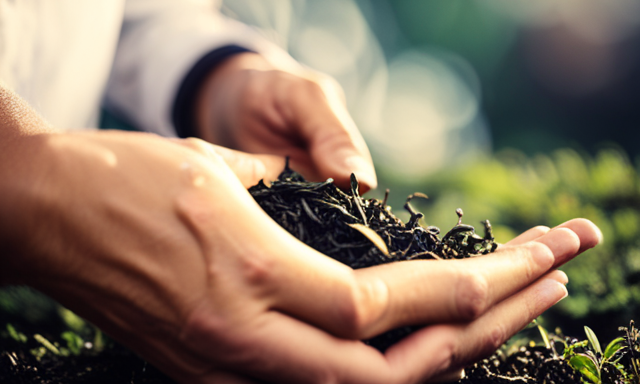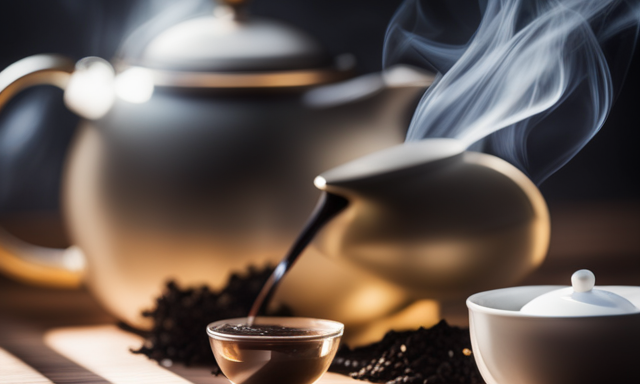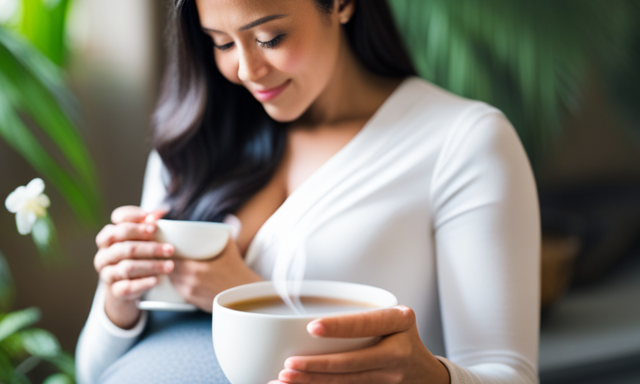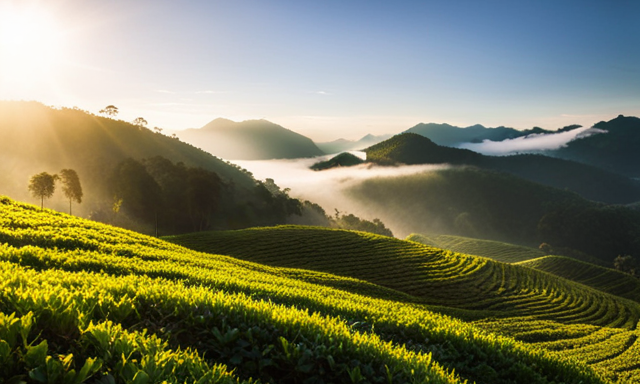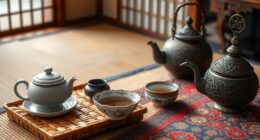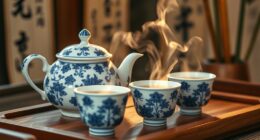Have you ever wondered how a simple tea leaf can transform into a beverage that captivates the senses and nourishes the body? Well, let me spill the tea on the fascinating process of making oolong tea. From the moment the tea leaves are plucked to the final sip, every step is carefully crafted to ensure a rich and flavorful experience.
First, the leaves are delicately plucked and hand-selected, ensuring only the finest quality makes the cut. Then, they undergo a series of natural processes, including withering and wilting, allowing them to release their unique aroma and flavor compounds. This is followed by oxidation, where the leaves are gently rolled and fermented, enhancing their taste and complexity.
After that, the leaves are meticulously sorted and graded, guaranteeing that each batch meets the highest standards. Finally, the finished tea is packaged and stored, ready to be brewed and enjoyed by tea enthusiasts worldwide.
Not only does oolong tea provide a delightful sensory experience, but it also boasts numerous health benefits. So, join me on this journey as we explore the artistry and science behind the making of oolong tea.
Key Takeaways
- Drying the leaves to preserve flavor and aroma is a crucial step in making oolong tea, using methods such as sun drying and oven drying.
- Preservation methods like sun drying and oven drying help retain delicate flavors and allow for controlled drying.
- Sorting and grading the leaves based on quality and size ensures only the best leaves are used, and determines brewing time and flavor intensity.
- Packaging and storage play a vital role in maintaining the flavor and freshness of oolong tea, by using vacuum-sealed bags, airtight containers, and avoiding light exposure.
Tea Leaf Plucking and Selection
Tea leaf plucking and selection is a crucial step in the process of making oolong tea. Skilled tea pluckers delicately handpick the leaves, ensuring that only the topmost leaves and buds are chosen. This meticulous selection process guarantees the highest quality tea.
Leaf quality assessment is another important aspect of this subtopic. The plucked leaves are examined for their color, size, and overall appearance. Only leaves that meet the strict criteria for oolong tea production are selected, ensuring the desired flavor and aroma.
As we move on to the subsequent section about withering and wilting, the carefully chosen leaves will undergo further transformation.
Withering and Wilting
Surprisingly, during the withering and wilting process, the leaves of this aromatic beverage are given ample time to lose their vibrant green color. This is a crucial step in oolong tea production, as it allows the leaves to undergo chemical changes that enhance their flavor and aroma.
There are various withering techniques used, including indoor withering and outdoor withering, each imparting a unique character to the tea.
The wilting process involves spreading the leaves on bamboo trays or cloth, exposing them to air and allowing moisture to evaporate. This gradual dehydration softens the leaves, making them more pliable for the next step.
As the leaves wither and wilt, they release a captivating fragrance that fills the air, evoking anticipation for the next stage: the oxidation process.
Oxidation Process
During the oxidation process, you’ll notice the leaves transforming into a rich, deep brown color, as their natural compounds react with the air and develop a complex flavor profile.
Oxidation variations play a significant role in the final taste of oolong tea. Different levels of oxidation can result in a wide range of flavors, from light and floral to dark and robust. The efficacy of oxidation levels depends on the specific type of oolong being produced.
For lighter oolongs, a shorter oxidation time is preferred to retain the tea’s delicate aroma and taste. On the other hand, darker oolongs require a longer oxidation period to develop their bold and earthy flavors.
After the oxidation process, the leaves are ready for the next crucial step: leaf rolling. This technique further enhances the tea’s flavor and aroma by breaking down the cell walls and releasing essential oils.
Leaf Rolling
When it comes to making oolong tea, leaf rolling plays a crucial role in the oxidation process. By breaking down the cell walls through rolling, the tea leaves are able to release their natural flavors and aromas.
Additionally, this process helps to shape the leaves into distinctive oolong tea forms, such as tightly rolled balls or twisted strips. These forms contribute to the overall appearance and taste of the final product.
Breaking Down the Cell Walls through Rolling
To achieve the desired flavor profile, you need to start by gently rolling the tea leaves to break down their cell walls. This process is crucial because it allows for maximum enzymatic breakdown, which enhances the taste and aroma of oolong tea. The cell wall structure of tea leaves consists of complex compounds that need to be broken down to release their full potential. By rolling the leaves, we create friction and pressure that ruptures the cell walls, releasing the enzymes that catalyze the chemical reactions responsible for flavor development. This step is vital in bringing out the unique characteristics of oolong tea. After breaking down the cell walls, the next stage involves shaping the leaves into distinctive oolong tea forms, ensuring that each sip delivers a delightful and memorable experience.
Shaping the Leaves into Distinctive Oolong Tea Forms
Craftsmen skillfully mold the leaves, transforming them into exquisite and recognizable forms that will captivate your senses. Leaf shaping is a crucial step in the process of making oolong tea, as it determines the final appearance and flavor of the tea.
The leaves are carefully twisted, curled, or rolled into various shapes, such as long, wiry strips or tightly rolled balls. This shaping process helps to enhance the tea infusion, allowing the leaves to unfurl and release their flavors gradually when brewed. The distinct shapes also contribute to the aesthetic appeal of oolong tea, making it a delight to behold.
As the leaves are shaped, they undergo a series of chemical changes that prepare them for the next stage of fermentation, which will further develop the intricate flavors and aromas of oolong tea.
Fermentation
Fermentation is a key step in the production of oolong tea, giving it a unique flavor and aroma. During this process, the leaves are carefully oxidized to control the level of oxidation and achieve the desired taste. Here are some important aspects of fermentation in oolong tea production:
-
Oxidation control: The level of oxidation is closely monitored to ensure that it falls within the desired range. This is crucial in determining the final flavor profile of the tea.
-
Fermentation duration: The duration of fermentation varies depending on the type of oolong tea being produced. It can range from a few hours to several days, with each duration resulting in a distinct flavor and aroma.
-
Aroma development: Fermentation plays a crucial role in enhancing the aroma of oolong tea. The process unlocks different compounds in the leaves, resulting in the characteristic fragrances associated with oolong.
-
Flavor complexity: The fermentation process adds complexity to the flavor of oolong tea. It brings out a range of flavors, from floral and fruity notes to deeper, more robust undertones.
As fermentation concludes, the next step in oolong tea production is firing and drying.
Firing and Drying
When it comes to firing and drying tea leaves, the key points to understand are how heat is used to halt the fermentation process and the importance of drying the leaves to preserve their flavor and aroma.
As a tea enthusiast, I know that firing the leaves not only stops the oxidation process but also helps to develop the unique flavors.
Additionally, drying the leaves properly is crucial to maintain the delicate aromas and ensure a longer shelf life for the tea.
Halting the Fermentation Process through Heat
To make oolong tea, you must carefully apply heat to the leaves at just the right moment, halting the fermentation process and allowing the flavors to develop. Halting the fermentation process is crucial in controlling oxidation and achieving the desired taste profile.
Once the leaves are plucked and withered, they are transferred to large pans or baskets and exposed to high temperatures. This heat stops the natural enzymatic reactions and prevents further oxidation. The timing and temperature of this step are critical, as too much heat can alter the delicate flavors.
By halting the fermentation process through heat, oolong tea makers can preserve the desired level of oxidation and allow the unique flavors and aromas to flourish. This step sets the stage for the next crucial step – drying the leaves to preserve flavor and aroma, ensuring a delightful cup of oolong tea.
Drying the Leaves to Preserve Flavor and Aroma
After halting the fermentation process, the next step in producing high-quality oolong is carefully drying the leaves to preserve their exquisite flavor and aroma. This crucial step ensures that the tea leaves retain their unique characteristics and deliver a truly enjoyable cup of tea. The drying process involves carefully controlled heat and airflow, which removes moisture from the leaves while preserving their natural flavors. One method commonly used is sun drying, where the leaves are spread out in the sun to naturally dry. Another method is oven drying, where the leaves are placed in a temperature-controlled oven. Both methods require precision and expertise to achieve the desired result.
To emphasize the importance of preserving tea leaves during drying, consider the following table:
| Preservation Methods | Benefits |
|---|---|
| Sun drying | Preserves delicate flavors |
| Oven drying | Allows for controlled drying |
After the leaves are properly dried, they are ready for the next stage: sorting and grading.
Sorting and Grading
When it comes to sorting and grading oolong tea, the leaves are separated based on their quality and size. This process ensures that only the best leaves are used for the final product.
Additionally, grading the leaves allows for the creation of different oolong tea varieties, each with its own unique flavor profile.
Separating the Leaves Based on Quality and Size
As you sort through the leaves, you can’t help but notice the stark contrast between the plump, vibrant ones and the withered, discolored ones.
The process of separating the leaves based on quality and size is crucial in the production of oolong tea. Size classification is an important factor as it determines the brewing time and flavor intensity of the tea.
Quality assessment, on the other hand, ensures that only the finest leaves are used for premium oolong tea. To evoke emotion in the audience, imagine the excitement of discovering a batch of perfectly sized, high-quality leaves. It’s like finding hidden treasure, knowing that these leaves will yield a tea of exceptional taste and aroma.
Moving forward, grading the leaves for different oolong tea varieties allows for a more refined and specialized brewing experience.
Grading the Leaves for Different Oolong Tea Varieties
To truly savor the exquisite flavors and aromas of different varieties of oolong tea, the leaves undergo a meticulous grading process. Grading techniques and tea leaf classification play a crucial role in determining the quality and characteristics of the final product.
The leaves are carefully examined based on factors such as size, color, shape, and aroma. Skilled tea tasters use their expertise to assign grades to the leaves, which can range from the highest quality to lower-grade leaves. This grading system ensures that each variety of oolong tea maintains its unique characteristics and taste profile.
The carefully graded leaves are then ready for the next step in the tea production process: packaging and storage. This ensures that the tea retains its freshness and quality until it reaches the hands of tea enthusiasts around the world.
Packaging and Storage
Proper packaging and storage are crucial for maintaining the flavor and quality of oolong tea. Here are four key techniques and practices to keep in mind:
-
Vacuum-sealed bags: Removing air and sealing in the freshness helps preserve the delicate flavors of oolong tea.
-
Airtight containers: Using containers with airtight seals prevents oxygen and moisture from degrading the tea’s quality.
-
Avoiding light exposure: Oolong tea should be kept away from direct sunlight to prevent oxidation and alterations in taste.
-
Cool and dry environment: Storing oolong tea in a cool, dry place helps maintain its flavor and prevents moisture absorption.
By following these packaging and storage guidelines, you can ensure that your oolong tea retains its exceptional taste and aroma.
Now, let’s move on to brewing and enjoying oolong tea, where we explore the art of extracting its unique flavors.
Brewing and Enjoying Oolong Tea
Indulge in the rich, aromatic experience of sipping a perfectly brewed cup of oolong tea and let its complex flavors dance on your taste buds. Brewing techniques play a crucial role in achieving the perfect cup. Start by heating water to around 190-200°F and steeping the tea leaves for about 3-5 minutes. This will allow the leaves to unfurl and release their unique flavors. The brewing time can be adjusted based on personal preference for a stronger or milder taste. Once brewed, take a moment to appreciate the amber-colored liquor and inhale the delightful aroma. Savor the first sip and let the tea coat your palate, noting the delicate balance of floral and fruity notes. Tea tasting is an art that allows you to explore the nuances of each cup. As we transition to the subsequent section about the health benefits of oolong tea, it’s important to understand the significance of brewing techniques in unlocking its potential.
Health Benefits of Oolong Tea
Experience a world of wellness as you discover the multitude of health benefits that can be derived from savoring a warm cup of oolong tea.
Oolong tea is not only a delicious and soothing beverage, but it also offers numerous advantages for your overall well-being.
One of the most notable benefits is its potential for weight loss. Oolong tea contains compounds that can help boost metabolism and promote fat burning, making it a great addition to a healthy weight loss regimen.
Additionally, oolong tea has been shown to enhance mental alertness. The caffeine and L-theanine present in oolong tea work together to improve focus, concentration, and cognitive function.
So, as you sip on a cup of oolong tea, not only will you enjoy its delightful taste, but you will also reap the benefits of weight management and improved mental performance.
Frequently Asked Questions
What is the history and origin of oolong tea?
Oolong tea has a rich history and fascinating origin. It dates back to the 18th century in Fujian, China. The name "oolong" means "black dragon" in Chinese, reflecting its dark, twisted leaves.
Are there any special types or varieties of oolong tea?
Yes, there are special types of oolong tea that offer unique flavors. These include Tie Guan Yin, Da Hong Pao, and Oriental Beauty, each with its own distinct taste profile and characteristics.
Can oolong tea be brewed multiple times?
Yes, oolong tea can be steeped multiple times. Re steeping oolong tea allows you to enjoy its complex flavors and aromas. The benefits include extracting different layers of taste and getting more value out of the tea leaves.
How does the taste of oolong tea compare to other types of tea?
The taste of oolong tea is a perfect balance between the boldness of black tea and the lightness of green tea. It has a rich and smooth flavor with floral and fruity notes. In addition to its great taste, oolong tea offers numerous health benefits.
Are there any specific brewing techniques or tips for making the perfect cup of oolong tea?
To make the perfect cup of oolong tea, I recommend using high-quality loose leaves and steeping them in hot water for 3-5 minutes. Adjust the brewing time to achieve the desired oolong tea flavors.
Conclusion
In conclusion, oolong tea is a delicate and intricate beverage that undergoes a meticulous process to achieve its unique flavors and health benefits.
Like a skilled craftsman shaping a masterpiece, each step in the tea-making process contributes to the final product.
Just as the careful selection and arrangement of colors can transform a blank canvas into a captivating painting, the plucking, withering, oxidation, rolling, and fermentation of tea leaves result in a delightful brew that captivates the senses.
So, sit back, sip on a cup of oolong tea, and let its artistry envelop you.
Cheers to the wonders of nature and human craftsmanship!

